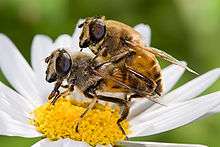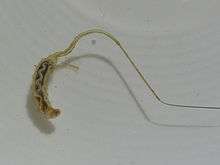Eristalis tenax
| Eristalis tenax | |
|---|---|
_female.jpg) | |
 | |
| both are females | |
| Scientific classification | |
| Kingdom: | Animalia |
| Phylum: | Arthropoda |
| Class: | Insecta |
| Order: | Diptera |
| Family: | Syrphidae |
| Genus: | Eristalis |
| Subgenus: | Eoseristalis |
| Species: | E. tenax |
| Binomial name | |
| Eristalis tenax (Linnaeus, 1758) | |
| Synonyms | |
Eristalis tenax is a European hoverfly, also known as the drone fly (or "dronefly"). It has been introduced into North America and is widely established.
Overview
The larva of E. tenax is a rat-tailed maggot. It lives in drainage ditches, pools around manure piles, sewage, and similar places containing water badly polluted with organic matter.[2] The larva likely feeds on the abundant bacteria living in these places.
When fully grown, the larva creeps out into drier habitats and seeks a suitable place to pupate. In doing so it sometimes enters buildings, especially barns and basements on farms. The pupa is 10–12 mm long, grey-brown, oval, and retains the long tail; it looks like a tiny mouse.
The adult fly that emerges from the pupa is harmless. It looks somewhat like a drone honey bee, and likely gains some degree of protection from this resemblance to a stinging insect. The adults are called drone flies because of this resemblance. In its natural habitat, E. tenax is more of a curiosity than a problem. Like other hover flies, they are common visitors to flowers,[3] especially in late summer and autumn, and can be significant pollinators.


Identification
Large (wingspan 15mm), stocky, bee mimic. Eyes are marbled in black. Males have hovering displays.
Diet
Adults feed on flowers, especially those of carrot and fennel.
Infection
There have occasionally been documented cases of human intestinal Myiasis of the rat-tailed maggot (larva of Eristalis tenax). Infection can be asymptomatic (no symptoms) or can manifest as symptoms ranging from abdominal pain, nausea and vomiting, to anal pruritus. Infection can be caused by ingestion of contaminated food or water but doubts have been expressed that accidentally ingested fly larvae could survive in the gastrointestinal tract. Zumpt proposed an alternative called "rectal myiasis". Flies, attracted to feces, may deposit their eggs or larvae near or into the anus, and the larvae then penetrate further into the rectum. They can survive feeding on feces at this site, as long as the breathing tube reaches towards the anus.[2][4]
References
- ↑ Stubbs, Alan E.; Falk, Steven J. (1983). British Hoverflies: An Illustrated Identification Guide. British Entomological & Natural History Society. p. 253, xvpp. ISBN 0-9502891-4-0.
- 1 2 Aguilera, A; Cid, A; Regueiro, BJ; Prieto, JM; Noya, M (1999). "Intestinal Myiasis Caused by Eristalis tenax". Journal of Clinical Microbiology. 37 (9): 3082. PMC 85471
 . PMID 10475752.
. PMID 10475752. - ↑ Van Der Kooi, C. J.; Pen, I.; Staal, M.; Stavenga, D. G.; Elzenga, J. T. M. (2015). "Competition for pollinators and intra-communal spectral dissimilarity of flowers" (PDF). Plant Biology. doi:10.1111/plb.12328.
- ↑ Phillip B. Whish-Wilson (2000). "A possible case of intestinal myiasis due to Eristalis tenax". Medical Journal of Australia. Retrieved January 13, 2008.
External links
| Wikispecies has information related to: Eristalis tenax |
| Wikimedia Commons has media related to Eristalis tenax. |
- Drone fly on the University of Florida / Institute of Food and Agricultural Sciences Featured Creatures website